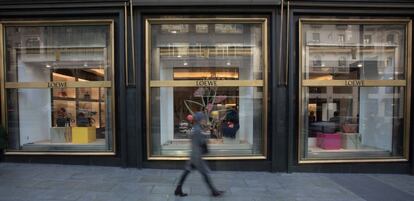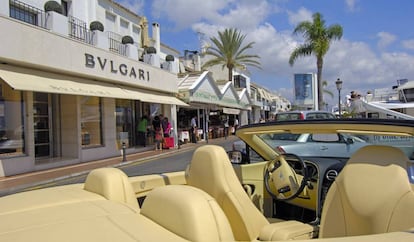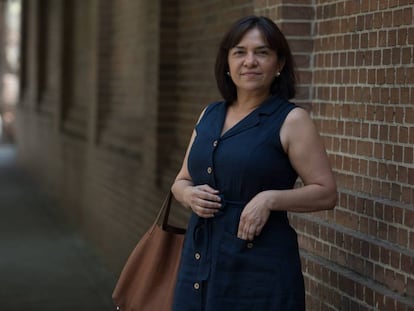Spain’s luxury market pins its hopes on Asia and millenials
Industry tries to close gap with world leaders through strong offer in high-end fashion, food and hospitality


Spain is keen to catch up with Europe’s luxury market leaders, and it predicts that it will be hard on their heels by 2025.
In 2017, Spain’s luxury sector had sales of €9.2 billion, compared to €29 billion in Italy and €27 billion in France. But experts believe that this figure will take just six years to rise to €20 billion. The leap will be based on Spain’s power of attraction in the segments of tourism, gastronomy, fashion and on the development of specific products for high-end consumers.
The last decade has proven that the luxury market is more resistant to crises than most
“There is a big gap between Spain and the leaders in Europe, but it is closing quickly. While they are growing at a rate of less than 5%, we are getting close to two digits,” says Carlos Falcó, president of the luxury brand association Círculo Fortuny and head of Eccia, an alliance of five national European luxury goods and creative industries organizations.
Falcó does admit, however, that 2018 did not live up to expectations. “It wasn’t a good year,” he says. “Tourism has been volatile, although we still have to see the last-quarter data, which could be significant. The fluctuation in some currencies has been very pronounced, and the significant drop in luxury taxes in China has meant that Chinese customers – who now make up a third of global sales and are predicted to make up half by 2025 – will buy in their own country instead of going abroad.”
But Falcó believes that there is still a good outlook for Spanish businesses in the luxury market, and he is not alone.

“We are optimistic for 2019,” says José María Folache, managing director of Tous, a jewelry maker that is one of the few Spanish brands to be ranked in the global luxury market. “The sector is still doing well. Christmas has been better than expected despite a boycott against Catalan products that meant a few months of losses in Spain. Now we have two or three years of 5% to 10% growth ahead of us.”
Folache highlights the importance of the millennial generation in the luxury market and points to the explosion of online sales, an area he recognizes that Spain has been slow to catch on to. “We have equated the channel with the price, and that is a mistake,” he says. “But in the not-too-distant future, 30% of the sector’s income will come from online sales.”
Folache’s forecast is shared by El Corte Inglés, which saw sales rise after the summer. A spokesman for Spain’s massive department store chain predicts that 2019 will be positive as long as the global economy does not go into a tailspin.
Market shift
There are two main factors driving the market: the advent of the millennials and the shifting sands in the Chinese market. Both of these factors are having a knock-on effect on brand philosophy, according to Susana Campuzano, director of the Luxury Universe Leadership and Management Strategy Program at the IE Business School. “The market is swinging strongly toward the casual,” she says. “Instead of shoes, the luxury brands are selling sneakers and instead of coats, down jackets… Even traditional brands such as Chanel are launching sports lines. It’s revolutionary. Luxury has never been made so democratic.”
The shift comes in response to the younger generations’ search for something exclusive and personalized rather than ostentatious. According to Campuzano, Gucci has taken the lead here, halving the cost of some of its products while broadening its client base. Luxury can be cheaper, as Hermés is also keen to demonstrate. Previously a prohibitively expensive brand, it has extended its collections to attract more customers and now sells jewelry from anywhere between €130 and €15,700.
Now we have two or three years of 5% to 10% growth ahead of us
José María Folache, Tous
Similarly, Tous has prices that range from €60 to €12,000. According to Campuzano, the collections are smaller but the turnover is greater because the pace of life is faster, and brands are responding by offering a wider range of products to suit almost every pocket.
But if the millennials are the present, the Chinese are the future. According to El Corte Inglés, Asian customers are still the main buyers of luxury goods in Spain. On average, a customer from this group will spend more than €1,000 on one shopping spree and in some areas, such as Madrid’s Castellana business area, the Asian shopper accounts for 70% of sales, with a preference among the Chinese for watches and jewelry.
Spain has good brands in this department, although the sector here is too small to compete with the French, Italians and the Swiss. The luxury vehicle market meanwhile is dominated by the Germans and Spain struggles to keep up here, too. But areas where it can surge ahead include the fashion and perfume sectors and, above all, the hospitality industry.
Galería de Canalejas, a project that is being developed inside the old Banesto headquarters complete with a five-star Four Seasons hotel, is investing strongly in this vision. When completed, it will attract almost 50 luxury brands, many of which will be new to the country, according to project director Juan Pablo García Denis, who believes six million customers will come on account of its mix of unique brands that “will revolutionize how luxury is understood as a lifestyle.”
Spain is well positioned and exports more than most of its competitors, according to Eduardo Irastorza, a lecturer at EAE Business School. However, there are many risk factors, such as Brexit, and the trade war between China and the US that could adversely affect the market. The president of Círculo Fortuny points out, however, that despite the volatility of the global economy, the last decade has proven that the luxury market is more resistant to crises than most.
English version by Heather Galloway.
Tu suscripción se está usando en otro dispositivo
¿Quieres añadir otro usuario a tu suscripción?
Si continúas leyendo en este dispositivo, no se podrá leer en el otro.
FlechaTu suscripción se está usando en otro dispositivo y solo puedes acceder a EL PAÍS desde un dispositivo a la vez.
Si quieres compartir tu cuenta, cambia tu suscripción a la modalidad Premium, así podrás añadir otro usuario. Cada uno accederá con su propia cuenta de email, lo que os permitirá personalizar vuestra experiencia en EL PAÍS.
¿Tienes una suscripción de empresa? Accede aquí para contratar más cuentas.
En el caso de no saber quién está usando tu cuenta, te recomendamos cambiar tu contraseña aquí.
Si decides continuar compartiendo tu cuenta, este mensaje se mostrará en tu dispositivo y en el de la otra persona que está usando tu cuenta de forma indefinida, afectando a tu experiencia de lectura. Puedes consultar aquí los términos y condiciones de la suscripción digital.
More information
Archived In
Últimas noticias
From Andorra to Gibraltar, a black market for Ozempic exploits its success: ‘They’re the most sought-after products in the world’
Magnets in their heads: How some animals guide themselves using the Earth’s magnetic field
From Hungary’s Orbán to Chile’s Kast: How Trump helps turbo charge the far right
The brief rise and retreat of Generation Z in Mexico
Most viewed
- Why we lost the habit of sleeping in two segments and how that changed our sense of time
- Trump’s obsession with putting his name on everything is unprecedented in the United States
- Charles Dubouloz, mountaineering star, retires at 36 with a farewell tour inspired by Walter Bonatti
- Venezuela faces its most tense Christmas yet
- The Florida Keys tourist paradise is besieged by immigration agents: ‘We’ve never seen anything like this’










































